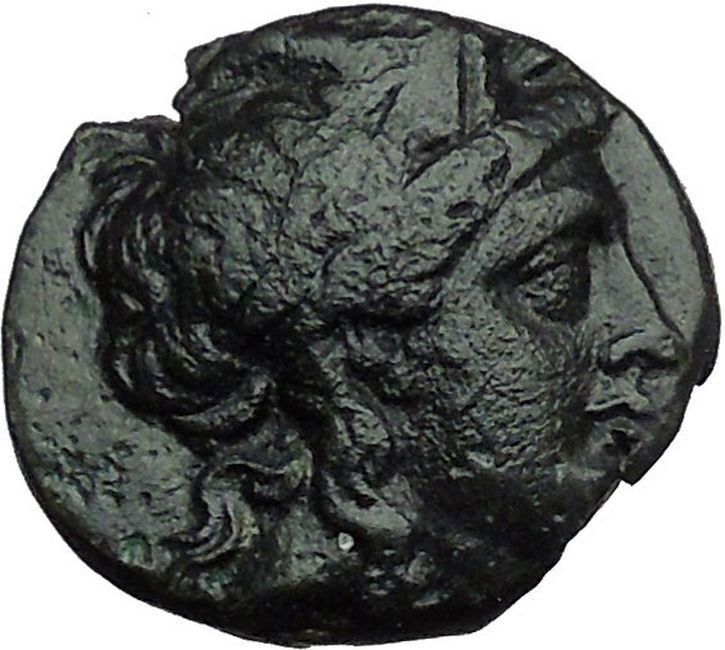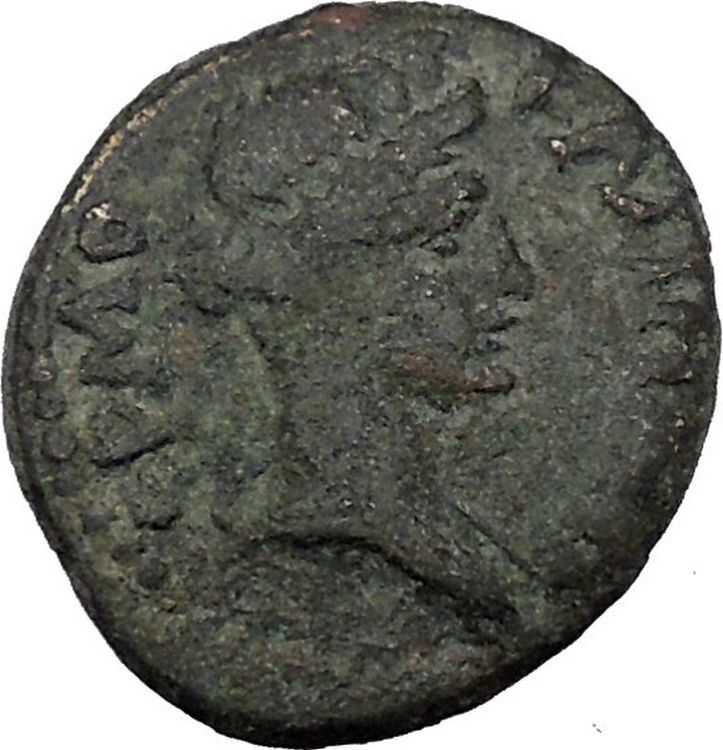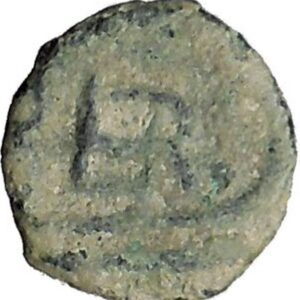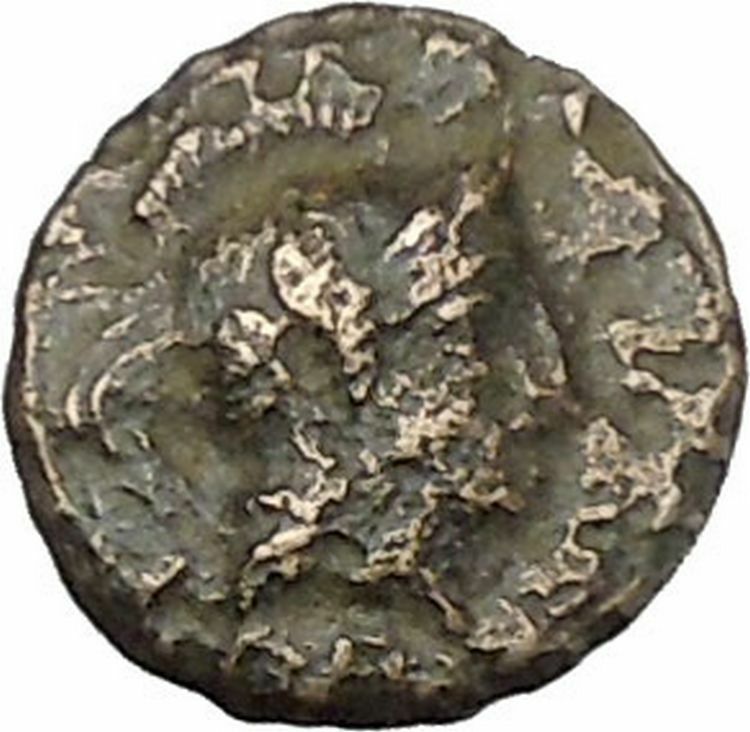|
Greek City of
Myrina in
Aeolis
Bronze 11mm (1.71 grams) Struck circa 2nd-1st Centuries B.C.
Reference: Sear 4221. B.M.C. 17, 137, 27; SNG München 574; SNG Copenhagen 226
Radiate head of
Helios right.
MY – PI either side of amphora.
Situated north-east of Kyme, Myrina was overshadowed by its
powerful neighbor, though it appears to have been a place of some importance in
Hellenistic times.
You are bidding on the exact item pictured,
provided with a Certificate of Authenticity and Lifetime Guarantee of
Authenticity.
Helios was the personification of the
Sun
in
Greek mythology
.
Homer
often calls him
Titan
or
Hyperion
, while
Hesiod
(Theogony
371) and the
Homeric Hymn
separate him as a son of the
Titans
Hyperion
and
Theia
(Hesiod) or
Euryphaessa
(Homeric Hymn) and brother of the
goddesses Selene
, the moon, and
Eos,
the dawn. Ovid
also calls him Titan.

Helios was imagined as a handsome god crowned with the shining
aureole
of the Sun, who drove the
chariot of the sun
across the sky each day to
earth-circling Oceanus
and through the world-ocean returned to
the East at night. Homer described Helios’s chariot as drawn by
solar steeds
(Iliad
xvi.779); later Pindar
described it as drawn by “fire-darting
steeds” (Olympian Ode 7.71). Still later, the horses were given fiery
names:
Pyrois
,
Aeos
,
Aethon
, and
Phlegon
.
As time passed, Helios was increasingly identified with the god of light,
Apollo
. However, in spite of their syncretism,
they were also often viewed as two distinct gods (Helios was a
Titan
, whereas Apollo was an
Olympian
). The equivalent of Helios in
Roman mythology
was
Sol
, specifically
Sol Invictus
.
Etymology
The Greek masculine
theonym
á¼Î»Î¹Î¿Ï‚ (Helios) is derived from the noun
ἥλιος, “Sun” in ancient Greek. The ancient Greek word derives from
Proto-Indo-European
.
Cognate
with
Latin
sol, Sanskrit
surya
, Old English swegl (sky-heavens)
Germanic sunna
. The female offspring of Helios were
called Heliades
.
Greek mythology
The best known story involving Helios is that of his son
Phaëton
, who attempted to drive his father’s
chariot but lost control and set the earth on fire.
Solar Apollo with the radiant
halo
of Helios in a Roman floor
mosaic,
El Djem
, Tunisia, late 2nd century
In one Greek vase painting, Helios appears riding across the sea in the cup
of the Delphic tripod which appears to be a solar reference.
Athenaeus
in
Deipnosophistae
relates that, at the hour
of sunset, Helios climbed into a great golden cup in which he passes from the
Hesperides
in the farthest west to the land of
the Ethiops, with whom he passes the dark hours. While
Heracles
traveled to
Erytheia
to retrieve the cattle of
Geryon
, he crossed the
Libyan
desert and was so frustrated at the heat
that he shot an arrow at Helios, the Sun. Almost immediately, Heracles realized
his mistake and apologized profusely, in turn and equally courteous, Helios
granted Heracles the golden cup which he used to sail across the sea every
night, from the west to the east because he found Heracles’ actions immensely
bold. Heracles used this golden cup to reach Erytheia.
By the Oceanid Perse, Helios became the father of
Aeëtes
,
Circe
, and
Pasiphaë
. His other children are Phaethusa
(“radiant”) and Lampetia (“shining”).
Helios and Apollo
Helios is sometimes identified with Apollo: “Different names may refer to the
same being,” Walter Burkert observes, “or else they may be consciously equated,
as in the case of Apollo and Helios.”
In Homer
,
Apollo
is clearly identified as a different
god, a plague-dealer with a silver (not golden) bow and no solar features.
The earliest certain reference to Apollo identified with Helios appears in
the surviving fragments of
Euripides
‘ play Phaethon in a speech
near the end (fr 781 N²),
Clymene
, Phaethon’s mother, laments that Helios
has destroyed her child, that Helios whom men rightly call Apollo (the name
Apollo is here understood to mean Apollon “Destroyer”).
By
Hellenistic
times Apollo had become closely
connected with the Sun in
cult
. His epithet
Phoebus, Phoibos
“shining”, drawn from
Helios, was later also applied by
Latin
poets to the sun-god Sol.

Coin of Roman Emperor
Constantine I
depicting
Sol Invictus
/Apollo with the legend
SOLI INVICTO COMITI, c. 315.
The identification became a commonplace in philosophic texts and appears in
the writing of
Parmenides
,
Empedocles
,
Plutarch
and
Crates of Thebes
among others, as well as
appearing in some Orphic texts.
Pseudo-Eratosthenes
writes about
Orpheus
in
Catasterismi
, section 24:
- “But having gone down into
Hades
because of his wife and seeing what
sort of things were there, he did not continue to worship
Dionysus
, because of whom he was famous,
but he thought Helios to be the greatest of the gods, Helios whom he also
addressed as Apollo. Rousing himself each night toward dawn and climbing the
mountain called Pangaion, he would await the sun’s rising, so that he might
see it first. Therefore Dionysus, being angry with him, sent the Bassarides,
as Aeschylus
the tragedian says; they tore him
apart and scattered the limbs.”
Dionysus and
Asclepius
are sometimes also identified with
this Apollo Helios.
Classical Latin poets also used Phoebus as a byname for the sun-god,
whence come common references in later European poetry to Phoebus and his car
(“chariot”) as a metaphor for the sun. But in particular instances in myth,
Apollo and Helios are distinct. The sun-god, the son of Hyperion, with his sun
chariot, though often called
Phoebus
(“shining”) is not called Apollo
except in purposeful non-traditional identifications.
Despite these identifications, Apollo was never actually described by the
Greek poets driving the chariot of the sun, although it was common practice
among Latin poets.. Therefore, Helios is still known as the ‘sun god’ – the one
who drives the sun chariot across the sky each day.
.JPG/220px-0_Alexander-Helios_Capitolini_(1).JPG)
Bust of
Alexander the Great
as Helios (Musei
Capitolini)
Cult of Helios
L.R. Farnell assumed “that sun-worship had once been prevalent and powerful
among the people of the pre-Hellenic culture
, but that
very few of the communities of the later historic period retained it as a potent
factor of the state religion.” Our largely Attic literary sources tend to give
us an unavoidable Athenian bias when we look at ancient Greek religion, and “no
Athenian could be expected to worship Helios or Selene,” J. Burnet observes,
“but he might think them to be gods, since Helios was the great god of Rhodes
and Selene was worshiped at Elis and elsewhere.” James A. Notopoulos considers
Burnet’s an artificial distinction: “To believe in the existence of the gods
involves acknowledgment through worship, as
Laws
87 D, E shows” (note, p. 264).
Aristophanes
‘ Peace (406-13) contrasts
the worship of Helios and Selene with that of the more essentially Greek
Twelve Olympians
, as the representative gods of
the
Achaemenid Persians
; all the evidence shows
that Helios and Selene were minor gods to the Greeks.
.jpg/200px-Colosse_de_Rhodes_(Barclay).jpg)
Colossus of Rhodes
“The island of Rhodes
is almost the only place where Helios
enjoys an important
cult
“, Burkert asserts (p 174), instancing a
spectacular rite in which a
quadriga
, a chariot drawn by four horses, is
driven over a precipice into the sea, with its overtones of the plight of
Phaethon
noted. There annual gymnastic
tournaments were held in his honor. The
Colossus of Rhodes
was dedicated to him. Helios
also had a significant cult on the
acropolis of Corinth
on the Greek mainland.
The tension between the mainstream traditional religious veneration of
Helios, which had become enriched with ethical values and poetical symbolism in
Pindar
,
Aeschylus
and
Sophocles
, and the Ionian proto-scientific
examination of Helios the Sun, a phenomenon of the study Greeks termed
meteora, clashed in the trial of
Anaxagoras
ca 450 BC, a forerunner of the
culturally traumatic
trial of Socrates
for irreligion, in 399.
In Plato
‘s
Republic
(516B), Helios, the Sun, is the
symbolic offspring of the idea of the Good.
Usil, the
Etruscan Helios
The Etruscan god of the Sun, equivalent to Helios, was Usil. His name
appears on the bronze
liver of Piacenza
, next to Tiur, the
moon. He appears, rising out of the sea, with a fireball in either outstretched
hand, on an engraved Etruscan
bronze mirror
in late Archaic style, formerly
on the Roman antiquities market. On Etruscan mirrors in Classical style, he
appears with a
halo
.
Helios Megistos
In
Late Antiquity
a cult of Helios Megistos
(“Great Helios”) (Sol
Invictus) drew to the image of Helios a number of
syncretic
elements, which have been analysed in
detail by Wilhelm Fauth by means of a series of late Greek texts, namely: an
Orphic
Hymn to Helios; the so-called
Mithras Liturgy
, where Helios rules the
elements; spells and incantations invoking Helios among the
Greek Magical Papyri
; a Hymn to Helios
by Proclus
;
Julian
‘s Oration to Helios, the last
stand of official paganism; and an episode in
Nonnus
‘
Dionysiaca
.
Consorts and children
- By
Aegle
the
Naiad
The Charites
(who
are otherwise called daughters of Eurynome with Zeus or
of Aphrodite with Dionysus):
-
Aglaea
“splendor”
-
Euphrosyne
“mirth”
-
Thalia
“flourishing”
- By Clymene, the
Oceanid
daughter of Oceanus
and Tethys
The Heliades
,
mostly represented as poplars mourning Phaëton’s death
beside the river
Eridanos
, weeping tears
of amber:
- Aetheria
- Helia
- Merope
- Phoebe
- Dioxippe
-
Phaëton
, the son who
borrowed the chariot of Helios, but lost control and
plunged into the river
Eridanos
-
Astris
, wife of the
river-god
Hydaspes
in India,
mother of Deriades
- By
Neaera
the nymph, two
daughters – guardians of the cattle of
Thrinacia
:
-
Phaethusa
-
Lampetia
(other sources list these two among the children of Clymene)
- By
Rhode
, the
Oceanid
daughter of
Oceanus
and
Tethys
The Heliadae
,
expert seafarers and astrologers from Rhodes:
-
Tenages
-
Macareus
-
Actis
-
Triopas
-
Candalus
-
Ochimus
-
Cercaphus
- Auges
- Thrinax
-
Electryone
|
- By Perse or Perseis, the
Oceanid
daughter of Oceanus
and Tethys:
-
Aega
-
Aeëtes
, ruler over
Colchis
-
Circe
, the minor
magicians’ goddess
-
Pasiphaë
, wife of King
Minos
of
Crete
-
Perses
- By
Ocyrrhoe
the
Oceanid
:
-
Phasis
, a river-god in
Colchis
- By Leucothoe, daughter of
Eurynome
and
Orchamus
:
- Thersanon
- By Nausidame, daughter of
Amphidamas
of
Elis
:
-
Augeas
, one of the
Argonauts
- By
Gaia
-
Bisaltes
- By
Selene
- The
Horae
(possibly; more
commonly known as daughters of
Zeus
)
- By unknown mothers:
-
Aegiale
, possible
mother to
Alcyone
- Aithon, who chopped Demeter’s sacred grove and was
forever famished for that (compare the myth of
Erysichthon
)
- Aix, a nymph with a beautiful body and a horrible
face
-
Aloeus
, ruler over
Asopia
- Camirus, founder of
Camira
, a city in
Rhodes
- Mausolus
-
Phorbas
, father of
Ambracia
|
Notes
- Listed above are the most common versions of the myths considering
mothers of Helios’ children; other ones are known as well, for instance:
- Rhode or the
Nereid
Prote were possible mothers of
Phaethon
- Ephyra, of Aeetes
- Antiope, of Aeetes and Aloeus
- Asterope, of Aeetes and Circe
-
Crete
, of Pasiphae
- Hyrmine
, of Augeas
- According to Ovid’s Metamorphoses,
Clytie
, sister of Leucothoe, also loved
Helios, but didn’t have her feelings answered
- Anaxibia
, an Indian Naiad, was lusted after
by Helios according to
Pseudo-Plutarch
Horses of Helios
Some lists, cited by
Hyginus
, of the names of horses that pulled
Helios’ chariot, are as follows.
According to
Eumelus of Corinth
– Eous; by him the sky is
turned. Aethiops, as if faming, parches the grain. These trace-horses are male.
The female are yoke-bearers:
Bronte
, whom we call Thunder, and
Sterope
, whom we call Lightning.
According to Homer, the names are :
Abraxas
, *Therbeeo.
According to Ovid:
Pyrois
,
Eous
,
Aethon
, and
Phlegon
“.
In
Greek mythology
, the
sun
was personified as (pronounced
/ˈhi�li.ɒs/
,
Greek
: á¼Î»Î¹Î¿Ï‚
“sun“,
Latinized
as Helius).
Homer
often calls him simply
Titan
or
Hyperion
, while
Hesiod
(Theogony
371) and the
Homeric Hymn
separate
him as a son of the Titans
Hyperion
and
Theia
(Hesiod) or
Euryphaessa
(Homeric Hymn) and brother of the
goddesses
Selene, the moon, and
Eos
, the dawn. The names of these three were
also the common Greek words for sun, moon and dawn.
Helios was imagined as a handsome god crowned with the shining
aureole
of the sun, who drove the
chariot of the sun
across the sky each day to
earth-circling
Oceanus
and through the world-ocean returned to
the East at night. Homer described Helios’s chariot as drawn by
solar steeds
(Iliad
xvi.779); later
Pindar
described it as drawn by “fire-darting
steeds” (Olympian Ode 7.71). Still later, the horses were given fiery
names:
Pyrois
,
Aeos
,
Aethon,
and
Phlegon.
As time passed, Helios was increasingly identified with the god of light,
Apollo.
However, in spite of their syncretism, they were also often viewed as two
distinct gods (Helios was a
Titan
, whereas Apollo was an
Olympian
). The equivalent of Helios in
Roman mythology was
Sol
, specifically
Sol
Invictus.
An amphora (plural: amphorae or amphoras) is a type of
vase-shaped, usually
ceramic
(specimens in materials such as metal
occur occasionally) container with two handles and a long neck narrower than  the the
body. The word amphora is
Latin
, derived from the
Greek
amphoreus (αμφο�ε�ς),
an abbreviation of amphiphoreus,
a compound word combining amphi- (“on both sides”, “twain”) plus
phoreus (“carrier”), from pherein (“to carry”), referring to the
vessel’s two carrying handles on opposite sides.
Further, the term also stands for an ancient
Roman unit of measurement
for liquids. The
volume of a Roman amphora was one cubic
foot
, ca. 26,026
L
.
Amphorae were used in vast numbers to transport and store various products,
both liquid and dry, in the ancient
Mediterranean
world and later the
Roman Empire
, and in some periods the shape was
also used for luxury pottery, which might be elaborately painted. Stoppers of
perishable materials which have rarely survived were used to seal the contents.
Two principal types of amphorae existed: the neck amphora, in which the
neck and body meet at a sharp angle; and the one-piece amphora, in which
the neck and body form a continuous curve. Neck amphorae were commonly used in
the early history of ancient Greece but were gradually replaced by the one-piece
type from around the 7th century BCE onwards. Most were produced with a pointed
base to allow upright storage by being partly embedded in sand or soft ground.
This also facilitated transport by ship, where the amphorae were tightly packed
together, with ropes passed through their handles to prevent breaking or
toppling during rough seas. In kitchens and shops amphorae could be stored in
racks with round holes in them.
Amphorae varied greatly in height. The largest could stand as much as 1.5
metres (5 ft) high, while some were under 30 centimetres (12 in) high – the
smallest were called amphoriskoi (literally “little amphorae”). Most were around
45 centimetres (18 in) high. There was a significant degree of standardisation
in some variants; the wine amphora held a standard measure of about 39 litres
(41 US qt), giving rise to the amphora quadrantal as a unit of measure in the
Roman Empire. In all, around 66 distinct types of amphora have been identified.

Myrina
(Ancient Greek:
Μυ�ίνα), was one of the
Aeolian
cities on the western coast of
Mysia
, about 40
stadia
to the southwest of
Gryneion
. Its site is believed to be occupied
by the modern
Sandarlik
at the mouth of the
Koca Çay
.
History
A terracotta figurine of a
harpocratic
Eros
from Myrina, ca. 100–50 BC.
It is said to have been founded by one Myrinus before the other Aeolian
cities, or by the Amazon
Myrina
.
Artaxerxes
gave Gryneium and Myrina to
Gongylus
, an
Eretrian
, who had been banished from his native
city for favoring the interests of
Persia
.
Myrina was a very strong place, though not very large, and had a good harbor.
Pliny
mentions the fame of its oysters and that
it bore the surname of Sebastopolis; while, according to
Syncellus
, it was also called Smyrna. An
inscription (Bulletin de correspondance hellenique, V, 283) tells us that Myrina
formed part of the Kingdom of
Pergamon
in the 3rd century BC. For some time
Myrina was occupied by
Philip V of Macedon
; but the
Romans
compelled him to evacuate it, and
declared the place free. It twice suffered severe earthquakes;
first
in the reign of
Tiberius
, on which occasion it received a
remission of duties on account of the loss it had sustained; and a second time
in the reign of Trajan
. The town was restored each time, and
continued to exist until a late period. It was the birthplace of Agathias, a
Byzantine poet and historian of the 6th century. Myrina minted coins in
antiquity, some of which survive.
Under Roman rule, Myrina was part of the
Roman province
of
Asia
and its bishopric was a suffragan of the
metropolitan see
of
Ephesus
. The names of some of its bishops are
known: Dorotheus, 431; Proterius, 451; John, 553; Cosmas, 787. It still existed
as a residential see in the 14th century, but is now included in the
Catholic Church
‘s list of
titular sees
.
The site of Myrina was discovered at the mouth of the river that was the
ancient Pythicos, whose alluvia have covered what was the city’s harbour.
Excavations (1880-1882) brought to light about four thousand tombs, dating from
the last two centuries BC, in which were found numerous objects representing the
divinities of the Greek pantheon; children’s toys, reproductions of famous
works, etc.: most of these may be seen today in the Museum of the Louvre.
Famous residents
|









.JPG/220px-0_Alexander-Helios_Capitolini_(1).JPG)
.jpg/200px-Colosse_de_Rhodes_(Barclay).jpg)
 the
the 



